Introduction
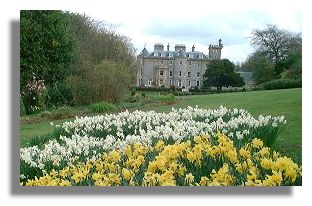 Like many people who drive along the A8 dual-carriageway between Paisley and Greenock, I used to whiz past the sign pointing to Finlaystone Country Estate, meaning to go in and never quite finding the time. But having explored the estate and the extensive gardens in recent years, Finlaystone has become one of my favourite places to spend an afternoon. I now have a season ticket and so have become a frequent visitor as Finlaystone is only ten miles away from where I live.
Like many people who drive along the A8 dual-carriageway between Paisley and Greenock, I used to whiz past the sign pointing to Finlaystone Country Estate, meaning to go in and never quite finding the time. But having explored the estate and the extensive gardens in recent years, Finlaystone has become one of my favourite places to spend an afternoon. I now have a season ticket and so have become a frequent visitor as Finlaystone is only ten miles away from where I live.
Finlaystone House incorporates a 15th century castle but it was extended and remodeled in 1760 and again between 1899 and 1903. The castle was originally the property of the Cunningham Earls of Glencairn and the 5th Earl invited John Knox to preach there in 1556. There is still an ancient yew tree under which Knox is said to have preached - though a later owner had the tree moved away from the house as it was blocking the light to the windows! Robert Burns, who was a friend of one of the Earls of Glencairn also visited the house.
Finlaystone is now a centre for the MacMillans and the clan is featured in a number of areas and have held gatherings there in recent years.
The Gardens

The gardens at Finlaystone are extensive and are built on the side of a hill, with glimpses of the river Clyde below, through the trees. In the spring, there are huge drifts of daffodils and narcissi on the hillsides.
One of the delightful aspects of the design is the way in which there are so many different sections, curves and pathways with different flowers and shrubs in each section. There are large beds of azaleas and rhododendrons but with such a range of varieties they produce a colourful display throughout the spring.
Near the entrance there are avenues of cherry and apple trees and later in the season there are the colourful white flowers, tinged with pink, of the cornus trees. The greenhouse has peach trees which produce a mass of pink blooms in the spring and later in the season the peaches themselves add a touch of colour - with clematis rambling across the roof outside.
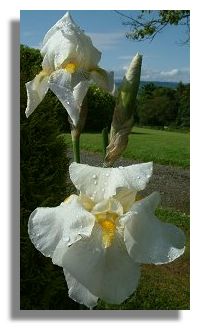
Elsewhere in the garden there is a marshy area with candelabra primulas and other plants that thrive on the wet conditions. And then there is the "Smellie Garden" which is a secluded area full of plants which produce all manner of scent.
Just as the azaleas are finishing their stunning display, the herbaceous flower beds take over with a succession of dazzling colours throughout the summer.
In this feature it is only possible to include a few illustrations of the flowers, shrubs and trees which are growing at Finlaystone. But on other pages, I have created a series of "Flipbooks" with a selection of graphics - with Javascript turning the pages for you in a succession of pictures. These Flipbooks cover:
April - rhododendron, bergenia, skimmia, tulips, spirea, anemone. May - azalea, broom, paeony, laburnum, primula, viburnum, hawthorn. July (Part 1) - lily, lavatera, astilbe, hydrangea, deutzia, phlox, clematis. July (Part 2) - geranium, buddleja, sedum, spirea, stachys, sidalcea.
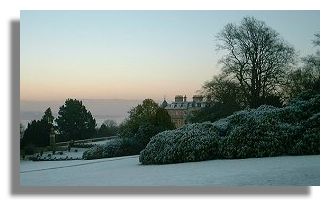
One of the great things about Finlaystone is that there is something to see every month of the year. There are, of course, special times when it is particularly at its best - when the snowdrops carpet the woods, when the daffodils cover the hillside, when the azaleas and rhododendrons are in bloom, when the masses of candelabra primulas in different hues are waving in the breeze or the autumn colours are painted on the trees. But no matter the time of year, there is always some corner with something worth seeing. Even in January, when this photo was taken, there is something of interest.
Woodland Adventure
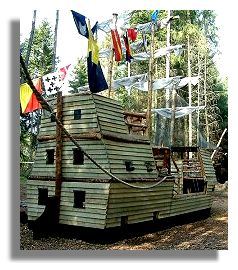 But Finlaystone isn't just about beautiful gardens. There is a large woodland area with well-marked (and not so well marked!) paths. The Eye Opener visitor centre can provide a map so that you don't get too lost.
But Finlaystone isn't just about beautiful gardens. There is a large woodland area with well-marked (and not so well marked!) paths. The Eye Opener visitor centre can provide a map so that you don't get too lost.
Kids are particularly welcome at Finlaystone with many events organised for the younger generation and special features have also been set up in the woodland area to keep them entertained. In addition to the more usual chutes for them to slide down, there is a "train" made from wood in which they can play and even a schooner, large enough for youngsters to sail the Inverclyde Main!
Wildlife
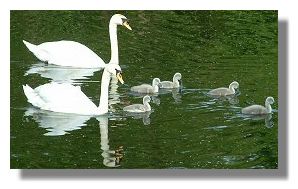
With so many trees and flowers, it is inevitable that lots of wild life is attracted to Finlaystone Estate. There is a constant background noise from the song birds and each year the resident swans rear their family of cygnets on an island in a large pond in the woods. There are lots of butterflies and moths and the staff at Finlaystone arrange organised walks during which they can point out various interesting aspects of the flora and fauna.
"Eye Opener"
If the weather is discouraging (or even when it's not) then the "Eye Opener" display of natural history, the history of the Clan MacMillan, a unique (and huge) collection of dolls from around the world and an appreciation of Celtic art will keep everyone occupied. There is also a "Celtic Tree" tea room from April to the end of September - most welcome after a long walk in the grounds.
Location
Finlaystone is well sign-posted on the A8 the main trunk road from Glasgow to Greenock. For a detailed location map, see StreetMap UK. (Note that you can access a larger scale map of the area via that Web page).
You can also find out more about Finlaystone Country Estate at their own Web site.
Return to the Main Index of Places to Visit.



